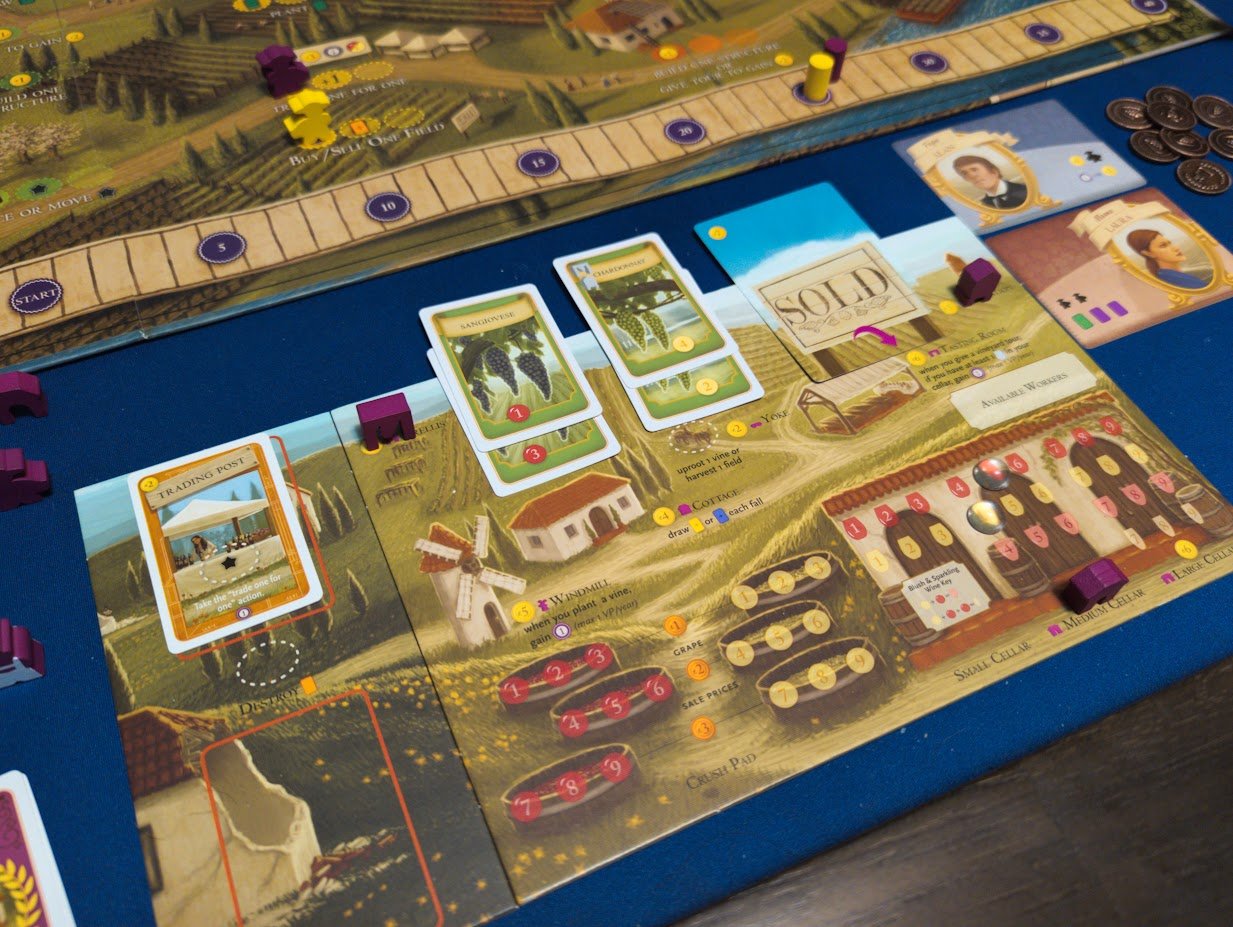“Age and glasses of wine should never be counted…” except for when you’re playing Viticulture. In my previous post about Wingspan I mentioned that it was the gateway to other Stonemaier games. Viticulture was the first big hit for Stonemaier and is the sole reason why Stonemaier has its name. It is designed by Jamey Stegmaier and Alan Stone. At the time, neither had board games of much significance in production, so they combined their names to create the name Stonemaier. Today, Alan Stone doesn’t have many credits while Jamey Stegmaier continues to be a giant in the world of board game design. Viticulture is a worker placement game that takes place over many years where each player competes to develop the most functional and profitable vineyard. There is a central board that has spaces for Summer actions and for Winter actions. In the Summer, the actions available typically focus on growing new crops, constructing buildings, and things of that nature. In the winter, you harvest and perform actions to increase profit. Each player starts with 3 workers but in the winter you can hire more workers who will permanently join your vineyard for the remainder of the game. Players with the most victory points at the end of the game win!
At first glance - the main way to gain victory points is by selling wine. This seems like the optimal action because that’s what the whole game is about! However; there is only one opportunity to sell wine, and that’s in the winter. With your Grande worker able to take actions that are already occupied, you’re able to ship 2 wine orders per year, maximum. That’s if you’re very lucky. Many of the wine actions take multiple years to fulfill. There are four types of wine to ship - White, Red, Blush, and Sparkling. To create white wine you must have white grapes growing in your vineyard. To make red, you need red grapes. Easy stuff. To make blush, you need to combine 1 red grape with 1 white grape. To make sparkling, you need 2 red grapes and 1 white. But that’s not all, you need a medium cellar to make blush and you need a large cellar to make sparkling. So even though blush and sparkling are great money makers, you need to invest quite a lot of money to even be able to produce these high value wines.
To help you along there are two types of cards players will be drawing throughout the game. These are Summer and Winter visitor cards. These cards typically contain powerful abilities that come with great benefit when timed right. Some of these abilities include constructing beneficial buildings at lower cost, performing multiple actions you normally can’t do together, and sometimes trading in grapes or wine for cash or victory points. These cards generate an alternative path to victory outside of the obvious of fulfilling wine orders. I’ve played games where my opponent fulfilled zero wine orders and won. In fact, I’ve seen people use this as a strategy more often than just wine order shipping.
This is something that fascinates me about Viticulture. The strategies one can employ are variable and fun. I love fulfilling wine orders. To me, that’s the most straightforward goal and the most thematic. I win with enough regularity to not think I need to adjust my strategy, I just need to be better about adjusting my strategy if I’m not getting the wine orders that fit with my board layout. The game is all about timing and building your engine. One game I still think about to this day is when I was playing a three player game where two of us recruited the maximum number of workers. To me, racing to get your final worker is a must. The more workers you have, the more options you have to win. But in this game, my friend Nick didn’t even bother getting his 6th worker, he just went with 5. He had an engine going that didn’t need 5. Looking back, Darryl and I were often at a loss as to what to do with your 6th worker. We barely benefited from having all 6. Nick won that game and it made me really rethink how I go about getting more workers. You clearly don’t need all 6 to win, which is fascinating to me.
Viticulture is one of my top games of all time. But do you want to know what’s better? Viticulture Tuscany: Essential Edition. It’s everything love about Viticulture but way more. Instead of placing workers in 2 season, you’re now placing workers in all 4 seasons. More actions are available but the number of workers you have hasn’t increased. It’s still a race to get to the good spots first but since you have more options you never feel like you’re lagging behind on strategy. There are more options to develop a secondary strategy and maintain relevance in the game. If you lose, it’s largely your fault for not being able to adjust your strategy. Worker placement games are often cutthroat but with Viticulture Tuscany: Essential Edition you’re given opportunities to turn the knife on your opponent. Your options open up to win so if you lose, you likely did it to yourself.
Have you played Viticulture? Have you played it with the Tuscany expansion? Do you prefer it with or without? Let me know in the comments!



